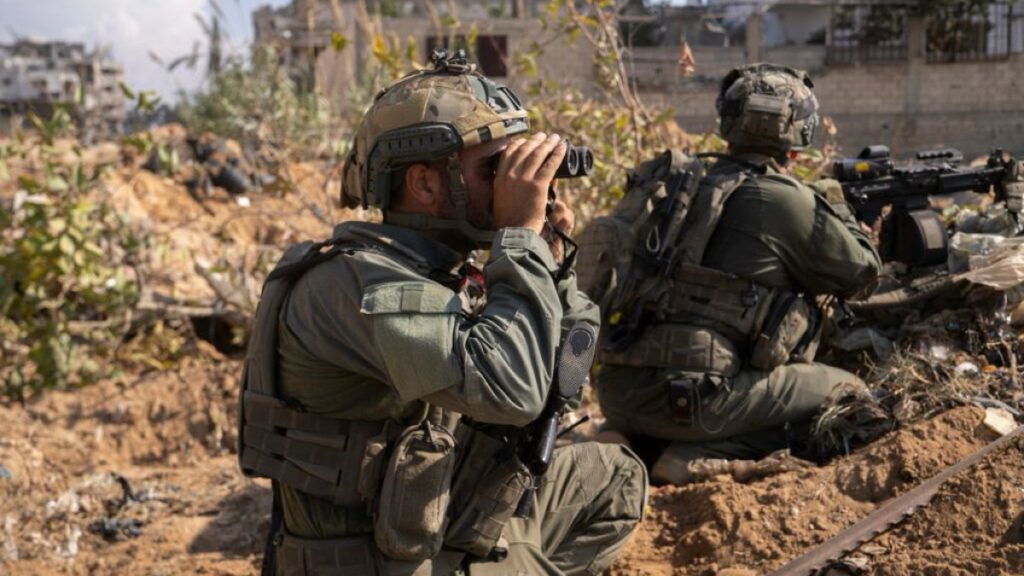Israeli troops have advanced toward Gaza City, the enclave’s largest population center, but face strong opposition from Palestinian fighters in the fight for the city as Gaza’s death toll totals exceeds 9,000.
Fighters from Hamas, the group that rules Gaza, and its ally Palestinian Islamic Jihad (PIJ) are jumping out of tunnels to fire on arriving Israeli tanks, before re-entering their vast underground network, residents and videos said of the two groups were broadcast on Thursday.
Guerrilla-style fighting has forced Israel, which often uses its powerful air force to strike Hamas hideouts from above, into a ground war as it seeks to topple the Palestinian group entirely.
The Israeli army announced Thursday that it had lost the commander of its 53rd battalion in the fighting, bringing to 18 the total number of Israeli soldiers killed since its ground raids intensified.
The commander, Lt. Col. Salman Habaka, is believed to be the highest-ranking Israeli officer killed since ground operations began in late October.
Israel said it also killed dozens of Palestinian fighters during the offensive.
As the death toll mounts, the war also moves closer to the population center of northern Gaza, from where Israel has ordered citizens to evacuate or risk being seen as “accomplices of terrorism.”
Israel continued to bombard the area with airstrikes, as military officials said they were assembling troops “at the gates of Gaza City.”
Hamas “well prepared”
Israel acknowledged that Hamas was “well prepared” for the battle, citing “minefields and booby traps” that made access to the city difficult.
“This is certainly a terrain more strewn with minefields and booby traps than in the past,” Brigadier General Iddo Mizrahi, chief of Israeli military engineers, told Army Radio. “Hamas learned well and prepared well,” he said.
Several axes
A resident of Gaza City told the Reuters news agency that Israel shelled the city throughout the night on Wednesday but was unable to encroach on the city limits.
“In the morning we (discovered) that Israeli forces are still outside the city, in the outskirts and this means that the resistance is stronger than expected,” said the resident, who requested the ‘anonymity.
Ejaz Haider, a military and foreign affairs analyst, told Al Jazeera that the Israeli army is moving along several axes to encircle places where it assumes Hamas fighters are located.
“One idea might be, given the number of reservists they called up, not only to saturate the area with firepower, which they did by air and artillery fire, but also to saturate the area with troops,” Haider told Al Jazeera. .
“For Hamas, it is by bringing them in that it will be able to inflict the maximum damage, at least in theory, on the arriving Israeli troops,” he added.
Attack on refugee camp
As Israel moves toward Gaza City, it has also carried out airstrikes on the densely populated Jabalia refugee camp, claiming to target leaders of Hamas’ Qassam Brigades hiding there.
Gaza authorities said at least 195 Palestinians were killed in the two strikes on Tuesday and Wednesday, with at least 777 injured and 120 others missing.
“It’s a massacre,” said a person at the scene quoted by Reuters.
Israel said it had killed two leaders of the Qassam Brigades in Jabalia.
The latest war between Israel and Hamas erupted when the Palestinian group staged a surprise attack on Israeli territory. Israel says the group has killed around 1,400 people, mostly civilians.
The ensuing Israeli bombardment of the enclave killed more than 9,000 people, including more than 3,700 children, according to Gaza authorities, while decimating the territory’s infrastructure and displacing hundreds of thousands of people.
Attacks “constitute war crimes”
The rising death toll and dire humanitarian conditions are drawing growing criticism from world leaders, activists and international bodies.
The United Nations High Commissioner for Human Rights recently expressed concern that Israel’s “disproportionate attacks…could amount to war crimes.”
Even the United States, Israel’s staunchest ally which gave it unwavering support during the war and proposed a $14.3 billion emergency aid package for its military, has begun to call for caution.
“I think we need a break,” US President Joe Biden said in a speech on Wednesday.
As part of a new diplomatic push, US Secretary of State Antony Blinken was to make his third visit to Israel on Thursday since the start of the war.
Blinken plans to meet with Prime Minister Benjamin Netanyahu on Friday to offer support, but also to emphasize the need to protect civilians as much as possible, his spokesperson said.
Exit route for injured foreigners
After a total blockade of Gaza for more than three weeks, foreign passport holders and some seriously injured people were allowed out under an Egyptian-brokered deal.
Palestinian border official Wael Abu Mehsen said 400 foreign citizens would leave for Egypt on Thursday via the Rafah crossing, after at least 320 people left Gaza on Wednesday.
Sixty other seriously injured Palestinians would also cross the border, Mehsen added.
A woman waiting to pass through the Rafah border crossing told Al Jazeera that Gazans were “living in agony”.
“I need a response from any (Egyptian) official. I have been here since the day the crossing was bombed weeks ago,” she said.
“I was supposed to leave 20 days ago. It’s too much; we live in agony. We were all close to death,” she said, holding her Egyptian passport.

